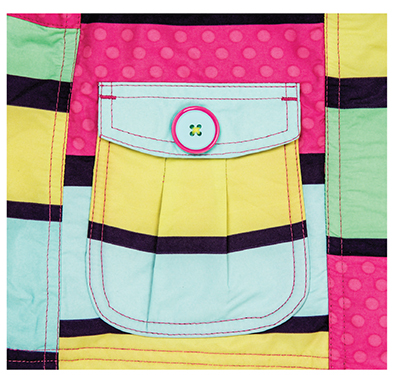Guide C-225
Revised by Wendy Hamilton
College of Agricultural, Consumer and Environmental Sciences, New Mexico State University
Author: Professor and CES Grants and Contracts Development Specialist, Department of Media Productions, New Mexico State University. (Print friendly PDF)
Patch pockets can be used for decoration or function on blouses, shirts, and jackets.
To prepare the pockets, cut the pocket as directed by the pattern. Patch pockets are generally cut on the lengthwise grain; however, a bias-cut pocket may be used on plaid or striped fabric to avoid having to match the fabric design.
An interfacing will help preserve the shape of the pocket. If a fusible interfacing is used, cut it to the finished pocket size and fuse in place. If a sew-in interfacing is used, cut it by the pocket pattern, stay-stitch in place, then trim it close to the stay-stitching. The hem of the pocket does not need to be interfaced.
Square Pocket
- Apply interfacing.
- Finish edge hem. Fold the hem to the right side of the pocket and stitch around the pocket on 5/8-in. line. Stitch from top to bottom on each side, then stitch from side to side across the bottom (Figure 1).
- Trim seam allowance of hem close to stitching (Figure 1). Turn hem right side out. Press pocket seam allowance along 5/8-in. stitching line.

Figure 1 - To miter the corners of the pocket, fold the bottom corners diagonally to line up stitching lines and press (Figure 2). Trim points to 1/4-in. seam allowance. Turn side seam allowance up and press to form mitered corners (Figure 3).

Figure 2

Figure 3 - Pin pocket in position on garment. Topstitch in place beginning at center of bottom and stitch to top of pocket on each side (Figure 4).

Figure 4 - Secure and reinforce top of pocket by sewing a bar tack or triangle in each corner (Figure 5).

Figure 5

© Andrey Armyagov | Dreamstime.com
Rounded Patch Pockets
- Apply interfacing.
- Finish edge of hem. Fold to right side of pocket and stitch around pocket on 5/8-in. seamline. To avoid stretching the pocket, stitch from center bottom to top on each side (Figure 6).

Figure 6 - Trim the seam allowance of hem close to the stitching. Turn hem right side out and press.
- Sew a row of gathering stitches on the 3/8-in. line around the bottom of the pocket (Figure 7).

Figure 7 - Trim seam allowances of rounded edges close to the gathering stitches (Figure 8).

Figure 8 - Pull up the gathering stitches around the curves just enough to shape the pocket curve along the 5/8-in. stitching (Figure 9).

Figure 9 - Trim and notch seam allowance, if necessary, to reduce puckers (Figure 10).

Figure 10 - Press pockets to form even, matching curves on each side of pocket (Figure 11).

Figure 11
- Pin pocket in position. Topstitch in place beginning at the bottom center and sew toward the top pocket on each side.
- Secure and reinforce the top of the pocket by backstitching or sewing a triangle in each corner (Figure 5)
For Further Reading
C-211: Sewing Sleeveshttps://pubs.nmsu.edu/_c/C211/
C-223: Collars
https://pubs.nmsu.edu/_c/C223/
C-231: Machine Buttonholes Made Easy
https://pubs.nmsu.edu/_c/C231/
All Clothing Publication Listing
https://pubs.nmsu.edu/_c/

Wendy Hamilton is an Extension Evaluation and Accountability Specialist at New Mexico State University who provides expertise for program development and evaluation. She has worked at four land-grant universities, and has a diverse background in textiles and clothing, adult education, 4-H youth-at-risk, horticulture, evaluation, and grant writing.
To find more resources for your business, home, or family, visit the College of Agriculture and Home Economics on the World Wide Web at pubs.nmsu.edu
Contents of publications may be freely reproduced for educational purposes. All other rights reserved. For permission to use publications for other purposes, contact pubs@nmsu.edu or the authors listed on the publication.
New Mexico State University is an equal opportunity/affirmative action employer and educator. NMSU and the U.S. Department of Agriculture cooperating.
Revised September 2016


